Standardization of internal cleanliness measurement methods for steel drums
Chairman of the Working Group of the Japan Steel Barrel Association
Yang Wenliang translation
Member of the Japan Steel Bar Association Working Group:
JFE Container Co., Ltd. Totofumi Fuga
D?(Daikan) Co., Ltd. Torao Sagawa
Japan Steel Bucket Co., Ltd. Takashi Okita
Kazuyuki Suzuki, Japan Steel Barrel Co., Ltd.
Kenji Mishina, Toho Sheet Products Co., Ltd.
Consumer demand
-- The chemical industry has the highest requirements for steel drums → Strongly requires the interior of the steel drum to be clean.
*Chemical products require that the surface of the raw materials should be cleaned.
* Especially the electronic materials, fine chemical products, precision equipment, etc. consisting of tree fingers require cleaner inside the barrel.
Recommendations of the ICDM standard
* At the ICDM International Conference, SEFA proposed to develop standards for the measurement of cleanliness inside steel drums.
* Based on this proposal, SSCI and JSDA began to study this proposal.
Changes in the use of new steel drums

Study on the pollution of fine particles inside steel drum
Composition of particulate pollutants
--Measurement methods:
Observe the filtered residue with a microscope
--ingredient:
(1) Coating fragments (carbon, titanium, magnesium, silicon)
(2) Dust (silicon, aluminum, calcium)
(3) Iron powder (iron)
(4) Particles (zinc, iron) falling off the closure
(5) Fiber (carbon)
(6) Toner (carbon)
Appearance of contaminated particles collected from inside the steel drum
- Examples of micro-slag on the filter -
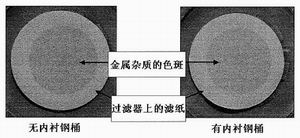
- Examples of microscope photos -
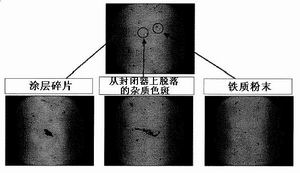
The process of contaminating particles into steel drums
(1) Entering the seam at the time of phosphating
→iron (iron), dust (silicon, aluminum, calcium), fiber (carbon)
(2) The outer coating film enters from the barrel plug
→ Metal particles (zinc, iron) entering from the sealer, particles (carbon, titanium, magnesium, silicon) that are detached from the undercoat layer
(3) After delivery (the closure is opened by the consumer)
→ Particles (zinc, iron) entering from the sealer, dust (silicon, aluminum, calcium) falling from the top of the barrel, and fragments of the inner and outer coatings (carbon, titanium, magnesium, silicon)
―Process chart -
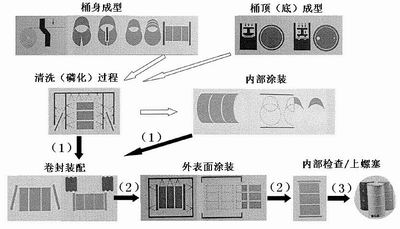
Steel drum internal cleanliness measurement method
JSDA
- There was a draft design for the instrument 13 years ago.
-- A new working group was established in June 2002.
(1) Study existing environmental conditions and amend a draft standard as proposed
(2) Conduct research using SEEA recommendations
Purpose: Revise a draft standard as proposed
JSDA measurement method
--cleaning method--

JSDA measurement method
- Pollution particle measurement method -
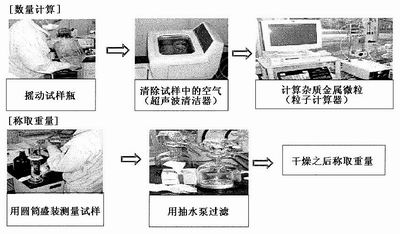
JSDA, SEFA and SSCI measurement methods
JSDA
SEFA
SSCI
(1) Steel drums of concern
Closed steel drum, 200 liters or more capacity
unspecified
(2) Cleanliness evaluation project
Weighing and counting of contaminated particles
Weight of contaminated particles
(3) Grading standards
NAS 1638 standard
unspecified
(4) Collection of contaminated particles
Inject 5 liters of isopropanol into the inside of the steel drum and collect the weighing washing solvent
Collecting contaminated particles (dust) with a vacuum filter (15 l/s)
(5) Pollution particle measurement
Calculate the contaminated micro-material in the washing solvent and weigh the filtered residue
Collect contaminated particles with a filter and weigh
SSCI measurement method
- Overview -
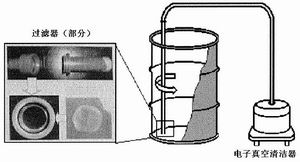
Comparison of JSDA, SEFA and SSCI measurement methods
JSDA
SEFA
Comparison of SSCIJSDA, SEFA and SSCI measurement methods
advantage
It is possible to obtain particle data of 5-15 micron size.
Comparative data can be obtained when filled with liquid.
Suitable for chemical suspension problems.
Simple operation can be placed outside the production line.
Most suitable for use in the production of standard drums.
Suitable for coating raw materials (to prevent paint filter clogging)
Disadvantage
Measurements must be made in the laboratory.
Only information on hard contaminated particles can be obtained.
Focus only on the external contaminated particles into the barrel.
It is difficult to measure closed steel drums (it is simpler for open steel drums).
Japan's steel drum cleanliness measurement example
Steel drum type
Manufacturer
Contaminants in liquid 200 liter steel drums
Number of particles: one per 100 ml
Particle weight
Particle size (micron)
Standard level
MG/barrel
Standard level
5-15
15-25
25-50
50-100
>100
Unlined steel drum
A
510
18
4
0
0
level 2
0.4
Level 100
434
20
5
0
0
Level 1
0.5
Level 100
B
113
12
5
0
0
Level 0
0.3
Level 100
433
42
14
1
0
Level 1
0.6
Level 100
C
459
8
0
0
0
Level 1
0.4
Level 100
529
12
3
0
0
level 2
0.7
Level 100
D
2777
57
11
0
0
level 4
1.3
Level 100
2554
33
7
0
0
level 4
1.6
Level 100
E
210
14
3
0
0
Level 0
0.2
Level 100
186
15
6
1
0
Level 0
0.6
Level 100
Lined steel drum
A
330
37
18
3
0
level 2
0.5
Level 100
128
17
8
1
0
Level 1
0.5
Level 100
B
394
61
25
3
0
level 2
1.1
Level 100
162
32
16
3
0
Level 1
0.6
Level 100
C
309
46
25
5
0
level 2
1.0
Level 100
285
39
20
3
0
level 2
0.8
Level 100
D
147
twenty four
14
4
0
level 2
0.6
Level 100
738
44
18
3
0
level 2
0.6
Level 100
E
126
twenty four
15
3
0
Level 1
0.3
Level 100
246
36
18
4
0
level 2
0.6
Level 100
JSDA example
1. Non-lined steel drum
Quantity: Standard level 0-4
Weight: 0.2-1.6 mg / barrel
Standard level 100
2. lining steel drum
Quantity: Standard level 1-2
Weight: 0.3-1.1 mg / barrel
Standard level 100
Measures to ensure the internal cleaning of steel drums in Japan
(1) Simplify the production process (avoid long-term inventory, if it is unavoidable, it must be protected against dust)
(2) Dust protection during product transportation
(3) Do not touch the chemical fiber gloves during the phosphating and sealing operation of the steel drum.
(4) Do not apply paint to the threaded part of the closure.
Use an external thread sealer.
Next plan
Drafting an ICDA standard
Promote the JSDA method among consumers
Standardization of measurement methods for drafting open steel drums and small and medium steel drums
Study methods for measuring other contaminants such as oils.
Massage And SPA Blend Essential Oil
Grapefruit Oil,Massage Oil,Lemongrass Oil,Bergamot Oil
Ji'An ZhongXiang Natural Plants Co.,Ltd. , https://www.zxessentialoil.com